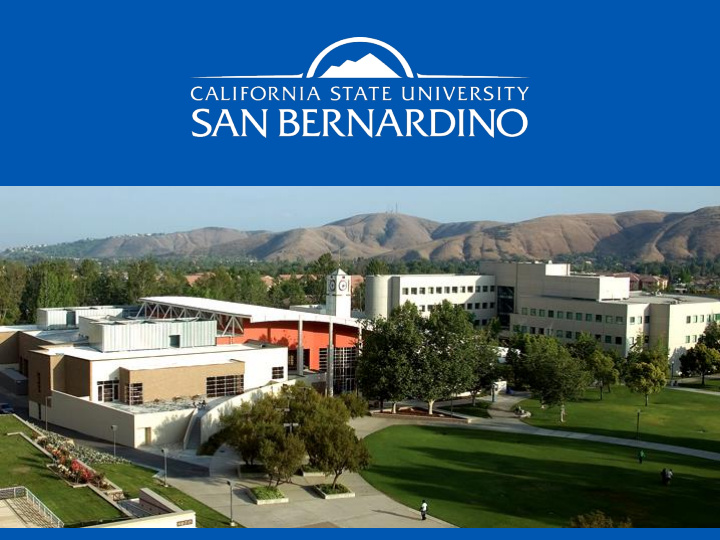



Partnerships that Work Collaborative Linking: Academic Advising and Career Center Services
Claudia Estrada M. Ed. Doctoral Candidate Eduardo A. Mendoza M.P.A Career Counselor Academic Success Coordinator cestrada@csusb.edu emendoza@csusb.edu
AGENDA CSU San Bernardino Looking at undeclared students Challenges and opportunities Partnership: Academic Advising and Career Services Next Steps
Established 1965 Public four-year university and post- baccalaureate 1 of 23 campuses in the CSU system Fall 2015 FTF cohort = 2972 – 55% (Parents have no college) – 80% (Parents have no degree)
OUR STUDENTS Fall 2015 Undergraduate Enrollment Total Students: 17,484 FTES: 15,710 2015 FTF 2972 Hispanic: 61% White: 14% African American: 6% Asian American: 6% Female: 61% Male: 39%
WELCOME! How many of you were ever undeclared/undecided as an undergraduate student? How many of you ever changed your major? What finally helped you decide on your major? What would you have done differently, if anything? How many of you used Academic Advising and/or Career Services?
UNDECLARED STUDENTS Students unwilling, unable, or unready to make educational and/or vocational choices Enter college with a tentative decision that changes Are not admitted to selective (impacted) programs Source: Chuck Lepper Ph.D.
WHY ARE THEY UNDECLARED? Informational Lack of information about self, major/disciplines, and careers Developmental Lack of knowledge regarding decision making processes; inability to make decision; or lack of vocational maturity or identity Personal/Social Concerns about personal values; interest vs. ability conflict; and influence of others Source: Chuck Lepper Ph.D.
ENROLLMENT OF UNDECLARED STUDENTS
CIRP FRESHMAN SURVEY
CHALLENGES & OPPORTUNITIES (Image source: “Square Wheels” Scott Simmerman )
CHALLENGE
CHALLENGE Avg. Major Avg. Years to Changes Degree Declared 1.0 5.2 Fall 2007 1.0 5.5 Fall 2008 0.9 5.3 Fall 2009 1.0 5.1 Undeclared 1.5 5.5 Fall 2007 1.5 5.7 Fall 2008 1.4 5.3 Fall 2009 1.6 5.1
RETENTION OF UNDECLARED STUDENTS
OPPORTUNITY Since student indecision as to major or career options is a primary factor in student persistence, advising programs should have strong links to the career services on campus as a part of any retention plan. Advising and career services should be, if possible, interrelated so that students see the connection between their academic planning and their career goals. (Charlie Nutt, NACADA Executive Director)
NEED FOR CAREER CENTER SERVICES All students need career advising, even those who enter college already decided on an academic major. (Gordon, 2006, p. 5)
CAREER CENTER SERVICES Individual Advising Choosing or changing majors Self-assessment tools Deciding on a career Planning a job or internship search Interviewing & negotiation Networking effectively Coping with career challenges and transition issues Applying to professional or graduate school
NEED FOR ACADEMIC ADVISING Tinto (1987) indicates that the factors in students dropping or 'stopping' out include academic difficulty, adjustment problems, lack of clear academic and career goals, uncertainty, lack of commitment, poor integration with the college community, incongruence, and isolation.
ACADEMIC ADVISING SERVICES Understanding of interrelatedness of academic decisions and future life and career goals Helping students to increase awareness of who they are, where they want to go, and how to make decisions to get there Proactive Advising (Tinto)
THE LINKS BETWEEN AA AND CCS Counseling and Listening Referring Building relationships Student Development Communicating Policies and Procedures Teaching Programs and Degrees Decision making Support Services Challenging & supporting
COLLABORATIVE PRACTICES SOAR (Student Orientation, Advising & Registration) – Co-facilitated presentation Advising holds MBTI assessment referrals Strong Interest inventory referrals “Coyote Success Week”
PARTNERSHIPS THAT WORK: NEXT STEPS Recommendations: Start collaborating on various projects Create “buy - in” Develop relationship with your IR departments Create an advisory board Be at your students first orientation Start tracking data EAB
Recommend
More recommend